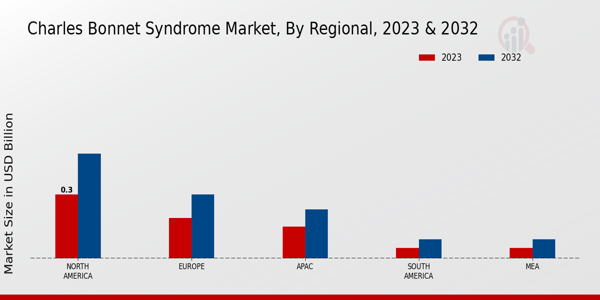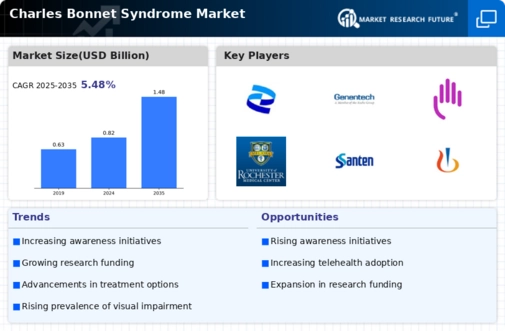In 2023, the Charles Bonnet Syndrome Market was valued at 0.74 USD Billion, showcasing its growing relevance in healthcare. Within this market, North America stands out, holding a significant portion with a valuation of 0.3 USD Billion, projected to rise to 0.49 USD Billion by 2032, indicating its majority holding in the market due to advanced healthcare systems and increased awareness. Europe follows with a valuation of 0.19 USD Billion in 2023, expected to reach 0.3 USD Billion, attributing its growth to an aging population and rising healthcare expenditure.
The APAC region also exhibits potential, valued at 0.15 USD Billion in 2023 and anticipated to grow to 0.23 USD Billion, driven by an increase in healthcare access.
South America and the MEA regions are currently valued at 0.05 USD Billion each, with projected growth to 0.09 USD Billion, indicating emerging opportunities as awareness and treatment options expand in these areas. Overall, the Charles Bonnet Syndrome Market segmentation reveals varied growth dynamics across regions, highlighting the significance of developed markets while also identifying untapped potential in emerging economies.
The Charles Bonnet Syndrome Market is evolving, with various Diagnosis Method strategies playing a crucial role in identifying and managing the condition. As of 2023, the overall market is valued at 0.74 billion USD, showcasing its significance in the healthcare industry. Within this framework, clinical evaluation stands out as a fundamental approach for diagnosing Charles Bonnet Syndrome, as it facilitates a detailed assessment of patient symptoms and histories.
Neuroimaging techniques also contribute significantly, allowing for the visualization of brain activities and abnormalities that may correlate with the syndrome, thus providing vital insights for healthcare providers.The role of psychiatric assessment is notable, as it aids in distinguishing Charles Bonnet Syndrome from other mental health disorders, ensuring accurate diagnosis and treatment.
Additionally, neuropsychological testing is important for evaluating cognitive functions and understanding how the syndrome impacts daily living, thereby enabling tailored therapeutic strategies. These methodologies collectively enhance the understanding and treatment options available within the Charles Bonnet Syndrome Market, reflecting a growing awareness and need for effective management solutions.The market is projected to reach 1.2 billion USD by 2032, driven by advancements in diagnosis and treatment approaches across these varied methods.
Charles Bonnet Syndrome Market Treatment Approach Insights
The Charles Bonnet Syndrome Market has shown notable value in the Treatment Approach segment, emphasizing various therapeutic modalities aimed at alleviating symptoms associated with this syndrome. As of 2023, the market has been valued at 0.74 billion USD, indicating a growing recognition of effective treatment strategies. Among the diverse methodologies, Pharmacological treatments hold considerable importance as they provide targeted relief through medication, while Psychological Counseling focuses on addressing the emotional and cognitive aspects of the syndrome.Vision Rehabilitation is particularly significant, as it helps patients adapt to their visual impairments, enhancing their quality of life.
Additionally, Supportive Therapies play a crucial role by offering complementary practices that assist patients in managing their condition holistically. The segmentation within the Charles Bonnet Syndrome Market not only reflects a comprehensive approach to treatment but also underscores the collaborative efforts needed to address the complexities of this disorder, highlighting trends and opportunities in market growth that cater to diverse patient needs.Understanding the nuances of these treatment approaches enables stakeholders to tap into emerging market opportunities and respond effectively to the evolving landscape of patient care.
Charles Bonnet Syndrome Market Patient Demographics Insights
The Charles Bonnet Syndrome Market, valued at 0.74 USD Billion in 2023, has been steadily driven by various patient demographics that affect the prevalence and management of the syndrome. A significant portion of the market is influenced by elderly patients, as they are more prone to vision loss and subsequently to the symptoms associated with Charles Bonnet Syndrome. Adults also represent an essential demographic, with increasing awareness and diagnosis contributing to market growth.
Additionally, the influence of children cannot be overlooked, albeit their numbers are smaller, as the early recognition of symptoms can lead to better outcomes and interventions.Gender differences play a crucial role in this market; research suggests variations in the onset and reporting of symptoms between men and women, influencing treatment approaches.
This diverse demographic segmentation highlights the varying needs and experiences of patients within the Charles Bonnet Syndrome Market, ultimately affecting the demand for tailored healthcare solutions, which contributes to the overall market growth. The dynamics surrounding patient demographics present both challenges and opportunities in understanding and addressing the complexities associated with this syndrome.
Charles Bonnet Syndrome Market Regional Insights
In 2023, the Charles Bonnet Syndrome Market was valued at 0.74 USD Billion, showcasing its growing relevance in healthcare. Within this market, North America stands out, holding a significant portion with a valuation of 0.3 USD Billion, projected to rise to 0.49 USD Billion by 2032, indicating its majority holding in the market due to advanced healthcare systems and increased awareness.
Europe follows with a valuation of 0.19 USD Billion in 2023, expected to reach 0.3 USD Billion, attributing its growth to an aging population and rising healthcare expenditure.The APAC region also exhibits potential, valued at 0.15 USD Billion in 2023 and anticipated to grow to 0.23 USD Billion, driven by an increase in healthcare access. South America and the MEA regions are currently valued at 0.05 USD Billion each, with projected growth to 0.09 USD Billion, indicating emerging opportunities as awareness and treatment options expand in these areas.
Overall, the Charles Bonnet Syndrome Market segmentation reveals varied growth dynamics across regions, highlighting the significance of developed markets while also identifying untapped potential in emerging economies.

Source: Primary Research, Secondary Research, Market Research Future Database and Analyst Review




















Leave a Comment